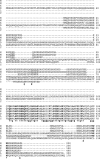Normal and disease-related biological functions of Twist1 and underlying molecular mechanisms
- PMID: 21876555
- PMCID: PMC3351934
- DOI: 10.1038/cr.2011.144
Normal and disease-related biological functions of Twist1 and underlying molecular mechanisms
Abstract
This article reviews the molecular structure, expression pattern, physiological function, pathological roles and molecular mechanisms of Twist1 in development, genetic disease and cancer. Twist1 is a basic helix-loop-helix domain-containing transcription factor. It forms homo- or hetero-dimers in order to bind the Nde1 E-box element and activate or repress its target genes. During development, Twist1 is essential for mesoderm specification and differentiation. Heterozygous loss-of-function mutations of the human Twist1 gene cause several diseases including the Saethre-Chotzen syndrome. The Twist1-null mouse embryos die with unclosed cranial neural tubes and defective head mesenchyme, somites and limb buds. Twist1 is expressed in breast, liver, prostate, gastric and other types of cancers, and its expression is usually associated with invasive and metastatic cancer phenotypes. In cancer cells, Twist1 is upregulated by multiple factors including SRC-1, STAT3, MSX2, HIF-1α, integrin-linked kinase and NF-κB. Twist1 significantly enhances epithelial-mesenchymal transition (EMT) and cancer cell migration and invasion, hence promoting cancer metastasis. Twist1 promotes EMT in part by directly repressing E-cadherin expression by recruiting the nucleosome remodeling and deacetylase complex for gene repression and by upregulating Bmi1, AKT2, YB-1, etc. Emerging evidence also suggests that Twist1 plays a role in expansion and chemotherapeutic resistance of cancer stem cells. Further understanding of the mechanisms by which Twist1 promotes metastasis and identification of Twist1 functional modulators may hold promise for developing new strategies to inhibit EMT and cancer metastasis.
Figures




References
-
- Nusslein-Volhard C, Wieschaus E, Kluding H. Mutations affecting the pattern of the larval cuticle in Drosophila melanogaster. Roux's Arch Dev Biol. 1984;193:267–282. - PubMed
-
- Murre C, McCaw PS, Vaessin H, et al. Interactions between heterologous helix-loop-helix proteins generate complexes that bind specifically to a common DNA sequence. Cell. 1989;58:537–544. - PubMed
Publication types
MeSH terms
Substances
Grants and funding
LinkOut - more resources
Full Text Sources
Miscellaneous

